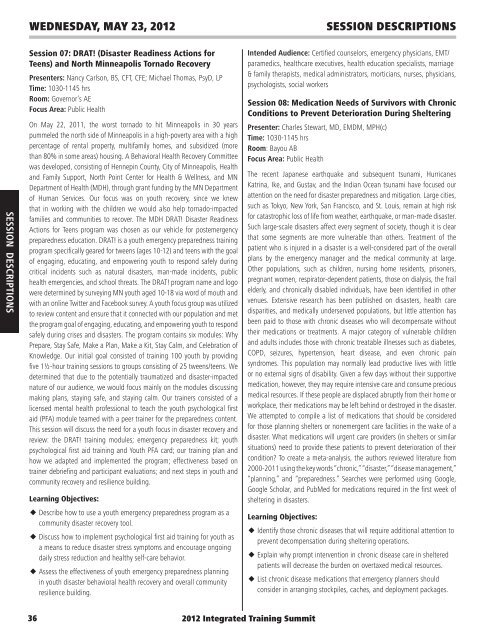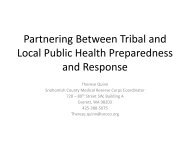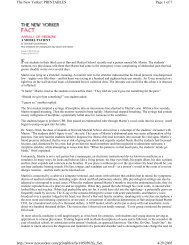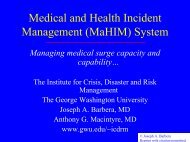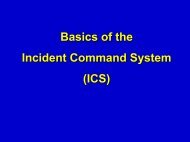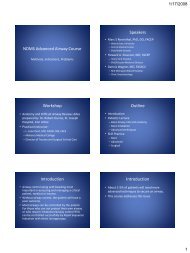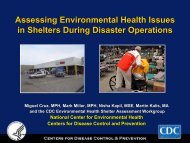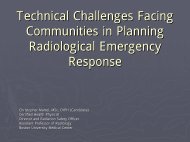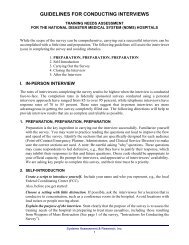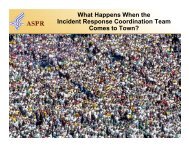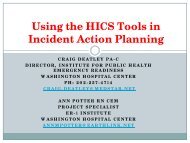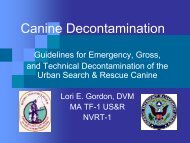wednesday, May 23, <strong>2012</strong>Session Descriptionssession DescriptionsSession 07: DRAT! (Disaster Readiness Actions forTeens) and North Minneapolis Tornado <strong>Recovery</strong>Presenters: Nancy Carlson, BS, CFT, CFE; Michael Thomas, PsyD, LPTime: 1030-1145 hrsRoom: Governor’s AEFocus Area: Public HealthOn May 22, 2011, the worst tornado to hit Minneapolis in 30 yearspummeled the north side of Minneapolis in a high-poverty area with a highpercentage of rental property, multifamily homes, and subsidized (morethan 80% in some areas) housing. A Behavioral Health <strong>Recovery</strong> Committeewas developed, consisting of Hennepin County, City of Minneapolis, Healthand Family Support, North Point Center for Health & Wellness, and MNDepartment of Health (MDH), through grant funding by the MN Departmentof Human Services. Our focus was on youth recovery, since we knewthat in working with the children we would also help tornado-impactedfamilies and communities to recover. <strong>The</strong> MDH DRAT! Disaster ReadinessActions for Teens program was chosen as our vehicle for postemergencypreparedness education. DRAT! is a youth emergency preparedness trainingprogram specifically geared for tweens (ages 10-12) and teens with the goalof engaging, educating, and empowering youth to respond safely duringcritical incidents such as natural disasters, man-made incidents, publichealth emergencies, and school threats. <strong>The</strong> DRAT! program name and logowere determined by surveying MN youth aged 10-18 via word of mouth andwith an online Twitter and Facebook survey. A youth focus group was utilizedto review content and ensure that it connected with our population and metthe program goal of engaging, educating, and empowering youth to respondsafely during crises and disasters. <strong>The</strong> program contains six modules: WhyPrepare, Stay Safe, Make a Plan, Make a Kit, Stay Calm, and Celebration ofKnowledge. Our initial goal consisted of training 100 youth by providingfive 1½-hour training sessions to groups consisting of 25 tweens/teens. Wedetermined that due to the potentially traumatized and disaster-impactednature of our audience, we would focus mainly on the modules discussingmaking plans, staying safe, and staying calm. Our trainers consisted of alicensed mental health professional to teach the youth psychological firstaid (PFA) module teamed with a peer trainer for the preparedness content.This session will discuss the need for a youth focus in disaster recovery andreview: the DRAT! training modules; emergency preparedness kit; youthpsychological first aid training and Youth PFA card; our training plan andhow we adapted and implemented the program; effectiveness based ontrainer debriefing and participant evaluations; and next steps in youth andcommunity recovery and resilience building.Learning Objectives:u Describe how to use a youth emergency preparedness program as acommunity disaster recovery tool.u Discuss how to implement psychological first aid training for youth asa means to reduce disaster stress symptoms and encourage ongoingdaily stress reduction and healthy self-care behavior.u Assess the effectiveness of youth emergency preparedness planningin youth disaster behavioral health recovery and overall communityresilience building.Intended Audience: Certified counselors, emergency physicians, EMT/paramedics, healthcare executives, health education specialists, marriage& family therapists, medical administrators, morticians, nurses, physicians,psychologists, social workersSession 08: Medication Needs of Survivors with ChronicConditions to Prevent Deterioration During ShelteringPresenter: Charles Stewart, MD, EMDM, MPH(c)Time: 1030-1145 hrsRoom: Bayou ABFocus Area: Public Health<strong>The</strong> recent Japanese earthquake and subsequent tsunami, HurricanesKatrina, Ike, and Gustav, and the Indian Ocean tsunami have focused ourattention on the need for disaster preparedness and mitigation. Large cities,such as Tokyo, New York, San Francisco, and St. Louis, remain at high riskfor catastrophic loss of life <strong>from</strong> weather, earthquake, or man-made disaster.Such large-scale disasters affect every segment of society, though it is clearthat some segments are more vulnerable than others. Treatment of thepatient who is injured in a disaster is a well-considered part of the overallplans by the emergency manager and the medical community at large.Other populations, such as children, nursing home residents, prisoners,pregnant women, respirator-dependent patients, those on dialysis, the frailelderly, and chronically disabled individuals, have been identified in othervenues. Extensive research has been published on disasters, health caredisparities, and medically underserved populations, but little attention hasbeen paid to those with chronic diseases who will decompensate withouttheir medications or treatments. A major category of vulnerable childrenand adults includes those with chronic treatable illnesses such as diabetes,COPD, seizures, hypertension, heart disease, and even chronic painsyndromes. This population may normally lead productive lives with littleor no external signs of disability. Given a few days without their supportivemedication, however, they may require intensive care and consume preciousmedical resources. If these people are displaced abruptly <strong>from</strong> their home orworkplace, their medications may be left behind or destroyed in the disaster.We attempted to compile a list of medications that should be consideredfor those planning shelters or nonemergent care facilities in the wake of adisaster. What medications will urgent care providers (in shelters or similarsituations) need to provide these patients to prevent deterioration of theircondition? To create a meta-analysis, the authors reviewed literature <strong>from</strong>2000-2011 using the key words “chronic,” “disaster,” “disease management,”“planning,” and “preparedness.” Searches were performed using Google,Google Scholar, and PubMed for medications required in the first week ofsheltering in disasters.Learning Objectives:u Identify those chronic diseases that will require additional attention toprevent decompensation during sheltering operations.u Explain why prompt intervention in chronic disease care in shelteredpatients will decrease the burden on overtaxed medical resources.u List chronic disease medications that emergency planners shouldconsider in arranging stockpiles, caches, and deployment packages.36<strong>2012</strong> Integrated Training Summit
wednesday, May 23, <strong>2012</strong>Session DescriptionsIntended Audience: Certified counselors, dentists, emergencyphysicians, EMT/paramedics, healthcare executives, health educationspecialists, marriage & family therapists, medical administrators, nurses,pharmacists, physicians, social workersSession 09: Triage in the Field: Taking It to theNext LevelPresenters: LT Christine Collins, BSN, MA; Jerardo Gomez, BSOE, AAS;David Torres, AASTime: 1030-1145 hrsRoom: Governor’s CFocus Area: Resource Management and Patient MovementTriage is a process for prioritizing the treatment and movement of casualtiesin order to provide the greatest care to the greatest number, achieving thebest possible outcomes. Effective triage and appropriate patient classification(Minimal=Green, Delayed=Yellow, Immediate=Red, and Expectant=Black)will maximize the life and limb-saving capabilities of medical personnel,equipment, and facilities. Providing hands-on, case-based scenarios withthe use of a human patient simulator will facilitate a comprehensive trainingenvironment, meeting the needs of all skill levels. <strong>The</strong> human patientsimulator is a computer-driven, multidiscipline tool that will demonstratea variety of human physiologic conditions related to injuries sustained <strong>from</strong>mass casualty events. Participants will be given instant and post-simulationfeedback during their demonstration of triage classification and medicalinterventions based upon the patient’s initial assessment and mechanism ofinjury. Since real-world emergency situations provide no room for error, thisparticular virtual learning environment will promote improved real-worldtriage care and increase the confidence of our medical responders.Learning Objectives:u List and define the four categories and colors of triage.u Verbalize and demonstrate the ability to properly triage and explainthe mechanism of injury with appropriate lifesaving intervention.u Recite appropriate physiologic theoretical data on virtual humanpatient simulator casualties and place them in their respectivecategories.Intended Audience: Emergency physicians, EMT/paramedics, healthcareexecutives, health education specialists, medical administrators, nurses,pharmacists, physicians, respiratory therapistsSession 10: ESF#8 Patient Tracking Force MultiplierPresenters: Knox Andress, RN, BA, AD; John Donohue, BS, EMT-P;Timothy Grapes, BA; Joe Lamana, MA, BA; Paul Petersen, PharmD, BCPSTime: 1030-1145 hrsRoom: Governor’s DFocus Area: Resource Management and Patient MovementMonitoring interstate and multi-jurisdictional patient movement duringemergencies has historically presented great challenges. Over the past twoyears, the Department of Homeland Security, the Department of Healthand Human Services, and their partners have worked collaboratively toidentify and develop holistic solutions that address tracking of patientswhile improving the overall situational awareness. This truly interactivesession will monitor the movement of the session participants in real timeas they are tagged (banded), registered, and moved among “locations” inthe room representing four disparate systems. Participants will be able to seethemselves being simultaneously transferred between systems and locationsas “emergency patients.” This session will include solutions for tracking bothNational Disaster Medical System (NDMS) and non-NDMS patients. Trackingsystems discussed and utilized will include those <strong>from</strong> Louisiana, Maryland,Tennessee, and the NDMS Joint Patient Assessment and Tracking System(JPATS). Overviews will include Federal, state, and local system roles andrelationships across the patient tracking continuum, including the TranscomRegulating and Command & Control Evacuation System (TRAC2ES) and others.This session will demonstrate how easily crucial information concerning thecare and tracking of patients can now occur to provide 360-degree situationalawareness during an emergency. Longitudinal patient tracking informationcan be maintained. <strong>The</strong> ability to electronically receive data-rich manifestsallows responders to lean forward and assist in ways never possible before inmass patient evacuation emergencies. With the aggregate data <strong>from</strong> thesecombined tracking systems, Department of Health and Human Services, theOffice of the Assistant Secretary for preparedness and Response (HHS/ASPR)can be fully aware of the locations and conditions of people, enabling a moredirected response while improving the ability of locating missing persons.Participants will be introduced to emerging data exchange standards,methods to seamlessly track patients in emergencies, bar coding technology,use of triage tagging systems, and mobile software applications. <strong>The</strong> sessionwill also delineate for participants implementation options available to theirorganization, provide step-by-step instructions, and identify organizationaland technology impediments to successful implementation. <strong>The</strong> session willalso introduce participants to the use of the National Health InformationNetwork (NHIN) and FEMA Integrated Public Alert and FEMA IntegratedPublic Alert and Warning System (IPAWS).Learning Objectives:u Describe the emerging data exchange architecture that is beingestablished to provide patient tracking in a timely and meaningfulfashion for future emergencies.u Explain how patient tracking systems and secure message routing canbe used for critical situational awareness during emergencies involvingmultiple jurisdictions and states.<strong>2012</strong> Integrated Training Summit 37session Descriptions
- Page 1 and 2: Leading from PreparednessThrough Re
- Page 3 and 4: Table of ContentsAmericans with Dis
- Page 5 and 6: Integrated Training Summit Partner
- Page 7 and 8: Focus area DescriptionsFocus Area D
- Page 9 and 10: Late Breakers & Early RisersTuesday
- Page 11 and 12: Handy Perforated Daily Agendas - De
- Page 13 and 14: Handy Perforated Daily Agendas - De
- Page 15 and 16: Handy Perforated Daily Agendas - De
- Page 17 and 18: Handy Perforated Daily Agendas - De
- Page 19 and 20: WorkshopDescriptions2012 Integrated
- Page 21 and 22: Monday, May 21, 2012Workshop Descri
- Page 23 and 24: MoNday, May 21, 2012Workshop Descri
- Page 25 and 26: MoNday, May 21, 2012Workshop Descri
- Page 27 and 28: Tuesday, May 22, 2012Workshop Descr
- Page 29 and 30: WEDNESday, May 23, 2012dMIS Worksho
- Page 31 and 32: ThurSday, May 23, 2012dMIS Workshop
- Page 33 and 34: SessionDescriptionssession Descript
- Page 35: wednesday, May 23, 2012Session Desc
- Page 39 and 40: wednesday, May 23, 2012u Provide ex
- Page 41 and 42: wednesday, May 23, 2012Session Desc
- Page 43 and 44: wednesday, May 23, 2012Session Desc
- Page 45 and 46: Thursday, May 24, 2012Session Descr
- Page 47 and 48: THURsday, May 24, 2012Session Descr
- Page 49 and 50: THURsday, May 24, 2012Session Descr
- Page 51 and 52: THURsday, May 24, 2012Session Descr
- Page 53 and 54: THURsday, May 24, 2012Session Descr
- Page 55 and 56: THURsday, May 24, 2012Session Descr
- Page 57 and 58: FRIday, May 25, 2012Session Descrip
- Page 59 and 60: Tuesday, May 22, 2012MRC WorkshopsM
- Page 61 and 62: Tuesday, May 22, 2012MRC WorkshopsL
- Page 63 and 64: Continuing Education InformationCon
- Page 65 and 66: Continuing Education InformationSes
- Page 67 and 68: Planning CommitteeDawn AnastasiaChe
- Page 69 and 70: PresentersBrian Abrahamson, BAGaylo
- Page 71 and 72: PresentersMary Massey, BSN, MA, MEP
- Page 73 and 74: Presenter DisclosuresAlliance betwe
- Page 75 and 76: 2012 Poster PresentationsMRCPoster
- Page 77 and 78: 2012 Poster PresentationsApplicatio
- Page 79 and 80: 2012 Poster PresentationsCollaborat
- Page 81 and 82: 2012 Poster PresentationsEducation
- Page 83 and 84: 2012 Poster PresentationsSpecial Co
- Page 85 and 86: Integrated Training Summit Acronym


